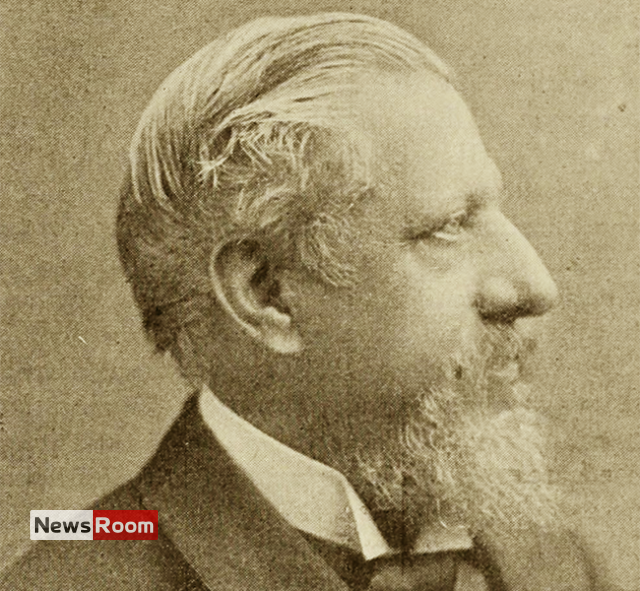by Rohana R. Wasala
Edwin Arnold’s purpose in composing the epic The Light of Asia, then, was to give readers an unbiased idea about the exalted personality of prince Siddhartha and the general substance of his teaching. But he was not addressing this task in a religious cultural vacuum. He had to take care not to step too hard on the religious toes of his contemporary Christian compatriots. Undaunted by that challenge, Arnold opens his monumental epic with the line ‘The Scripture of the Saviour of the World’, which was startling in its being used to mean the Buddha and his doctrine. It must have sounded very distasteful to the Christian readers of the West, because it was not about Christ, but about the little known Indian sage the Buddha.
But then, it was a time of profound intellectual upheaval. The Age of Reason or the Enlightenment in Europe of well over one and a half centuries duration had preceded Charles Darwin’s revolutionary theory of biological evolution, that came to be known to the world through the publication of his epoch-making book ‘On the Origin of Species by Means of Natural Selection’ (1859). By that time the Buddha was not totally unknown in the West. Ideas of ancient Eastern philosophers like Confucius of China and the Buddha of Bharat (India) as well as thoughts of their Western counterparts like Plato had influenced European thinkers of the time such as David Hume, Emmanuel Kant, and John Locke who figured in the enlightenment movement in Europe that came to be called the Age of Reason (1685-1815). The growing scientific ethos among the people undermined traditional religion and the fast spreading general scepticism regarding long held beliefs dealt a severe blow on theistic religion. Edwin Arnoldl’s senior contemporary Matthew Arnold (1822-1888), in his dramatic monologue ‘Dover Beach’ (1867), could only hear the receding ‘Sea of Faith,’
Its melancholy, long, withdrawing roar Retreating to the breath Of the night-wind, down to the vast edges drear And the naked shingles of the world.
The bleak barren desolate scene (with the ‘naked shingles of the world’: picture the wet pebbles on the indifferent beach constantly washed by the weeping waves) is a very depressing image of the uncertainty, the despair and the sadness that descended on a world that was losing the emotionally stabilising power of traditional religious faith. But it was also a time of bold inquiry and burgeoning hope. Edwin Arnold must have been emboldened by the existing zeitgeist of his time to shock his potential readers thus, only to offer them another more rational source of refuge to explore.
In terms of structure, The Light of Asia consists of eight cantos: Book the First, Book the Second, and so on up to Book the Eighth. The long epic poem employs the blank verse form, that is, lines of poetry without rhyme, that use a definite metre (a recurring pattern of rhythm) nevertheless. From the beginning to the end, the narrative is delivered in iambic pentameter lines (i.e., each line is made up of five metrical feet, each foot here being an iamb, that is, a foot consisting of a short syllable followed by a long syllable. Take any line from the poem, you can scan it into five iambic feet. But of course, occasionally, there are functional variations of the metre (as explained below). The opening line of Book the First (hence, of the whole poem) is ‘The Scripture of the Saviour of the World’, which can be scanned thus: The Scrip/ture of/the Sa/viour of/the World; the resulting stress pattern highlights the important words: Scripture, Saviour, World. The blank verse form more closely imitates the rhythm of natural speech than rhymed verse does, and, additionally, it makes for easy narrative continuity.
In Book the First, we are given the usual fictionalised narrative of how the Buddha-to-be descended from heaven to be born in the world of humans. Arnold recounts such details as Maya’s dream, its interpretation, and before all that, the ‘five sure signs of birth’ (which, though not specified in the poem, are equivalent to what we are familiar with as the Pas Maha Belum/the Great Fivefold Observation kaalaya, deepaya, deshaya, kulaya, maata/time, land, state, caste, mother) that preceded the Bodhisattva’s descent to the earth from ‘that sky’ (or the Tusita heaven according to Theravada Buddhist literature).
(Queen Maya)
Dreamed a strange dream; dreamed that a star from heaven –
Splendid, six-rayed, in colour rosy-pearl,
Whereof the token was an Elephant
Six-tusked, and white as milk of Kanadhuk –
Shot through the void; and shining into her,
Entered her womb upon the right…….
Thus was Siddhartha (the Bodhisattva/Buddha-to-be) conceived in his earthly mother’s womb. The birth takes place under a Palsa in the Palace-grounds in Kapilavastu (instead of under the shade between two Shala/Sal or cannonball trees on the way to Maya’s maternal home in Rajagriha/Rajgir, according to the story we know):
The conscious tree bent down its bows to make
A bower about Queen Maya’s Majesty;
And Earth put forth a thousand sudden flowers
To spread a couch……………
The narration of these miraculous occurrences which were claimed to have accompanied the birth of Siddhartha (‘All-Prospering’) did not spoil my enjoyment of the story, which was already known to me with similarly fantastic details, despite my then growing scepticism towards religion. People of different faiths usually adopt a healthy ‘suspension of disbelief’ when confronted with such fanciful accounts of events connected with the lives of religious figures that they adore, mostly because they are rational enough to read them as literature (a fact that Arnold himself was aware of and wanted his readers to understand as well).
The Queen mother dies seven days after the prince’s birth because she was ‘grown too sacred for more woe – And life is woe…………’
When old enough to learn all that a prince should learn, Siddhartha is entrusted to the wisest teacher available: Vishvamitra. But struck by the extraordinary precocity of his ‘softly-mannered, modest, deferent, tender-hearted…..’ royal charge, the old teacher
Prostrated before the boy; “For thou”, he cried,
Art Teacher of thy teachers – thou, not I,
“Art Guru. Oh I worship thee, sweet Prince!
The young prince also excelled in physical feats that formed a part of his training. He was a bold horseman and a skillful chariot driver. But he was so kindhearted that
Yet in mid-play the boy would oft-times pause,
Letting the deer pass free; would oft-times yield
His half-won race because his labouring steeds
Fetched painful breath; ……………………
One day while in play, Siddhartha’s cousin Devadatta shot a swan with an arrow and the injured bird fell to the ground. Siddhartha picked it up, removed the dart, and applied a poultice of soothing herbs on the wound. Though Devadatta wanted to have the bird that he had shot down, Siddhartha refused to give it back. An unknown priest suddenly appeared to mediate between the two cousins, and handed the bird to Siddhartha, saying that ‘the cherisher of life deserved the living bird, and not its slayer’. When the father king looked for the mysterious priest to reward him, he was gone:
And someone saw a hooded snake glide forth, –
The gods come oft-times thus! So our Lord Buddh
Began his works of mercy………………
It is in Book the Second that Arnold is seen giving full play to whatever he imbibed from his literary-aesthetic interaction with the Gita Govinda of Jayadeva, which Arnold seems to have used as a model for his own poetic masterpiece. The absolute devotion to the Buddha that Arnold expresses as an imaginary Buddhist votary in the capitalised last lines of the poem quoted in the epigraph to this essay indicates that his discovery of Buddhism was indeed a life changing experience.
While continuing my own narrative here, I consider this point an appropriate place to say something again about the form of the epic poem we are having a glance at. Now, too rigid an adherence to a set metrical foot is boringly mechanical at times (See the second paragraph above). Poets avoid this by varying it according to the context (as Shakespeare did in his plays). For example, from Book the Second we have
‘But they/ who watched/ the Prince/ at prize/-giving
Saw and/ heard all/ and told/ the care/ful King’
Here, the first line is a perfect iambic pentameter line. In the second line, however, the first two feet are trochees, not iambs; in a trochee, in contrast to an iamb, the stress or accent falls on the first syllable: Saw and/heard all/…. The context in the poem is where some courtiers, who have been attending on prince Siddhartha during a festival of royal beauties arranged by his father the ‘careful’ (full of care, i.e., worried, anxious) king Suddhodana on the advice of his wisemen to distract his eighteen year old young son from a premature otherworldliness that they had observed in his demeanour, are reporting to the king a sudden brightening of the prince’s mood on seeing the beautiful princess Yashodhara. What the watchful guards saw and heard passing between the two (Siddhartha and Yashodhara) gladdened them: they had instantly fallen in love with each other.
Whereas every one of the other maidens who came to receive gifts from the prince that day, even the fairest one among them,
….stood like a sacred antelope to touch
The gracious hand, then fled to join her mates
Trembling at favour, so divine he seemed,
So high and saint-like and above her world,
Yashodhara alone ‘Of heavenly mould’
Gazed full – folding her palms across her breasts –
On the boy’s gaze, her stately neck unbent.
“Is there a gift for me?” she asked, and smiled.
“The gifts are gone”, the Prince replied “yes take
This for amends, dear sister, of whose grace
Our happy city boasts”, therewith he loosed
The emerald necklet from his throat, and clasped
Its green beads round her dark and silk-soft waist;
And their eyes mixed, and from the look sprang love.
Those who stood nearest (the guards, no doubt) saw ‘the princely boy – Start, as the radiant girl approached….’ and they heard the sweet exchanges between the two instant lovers.The brief break in the metre in the verse line that records this highlights their (the guards’) joy and excitement at being finally able to bear the long awaited news of their happy finding to the fond father, the king they serve with so much love and loyalty.
This is a climactic moment of the whole scene (where the prince, set to choose his bride/his future queen consort, has just been rescued from his accustomed otherworldly melancholia). The king’s stratagem seems to be working. He wants his son to be a Chakravartin (lit. Turner of the Disc, a universal monarch) who will rule the world, not a holy man of wondrous wisdom. (As described in Book the First, these were the two alternative destinies that the dream-readers predicted for the baby conceived that night by Queen Maya. Ultimately, though,as we know, the king’s ambition for his son was not fulfilled. Siddhartha became Buddha instead of a Chackravartin.)
Long after Siddhartha attained Buddhahood, he is asked “why thus his heart – Took fire at first glance of the Sakya girl”, and he recalls an earlier life long gone by as
A hunter’s son, playing with forest girls
By Yamun’s springs, where Nandadevi stands,
Sate umpire while they raced beneath the firs
……………………………………………..
One with fir-apples; but who ran the last
Came first for him, and unto her the boy
Gave a tame fawn and his heart’s love beside.
This is just like a scene from Jayadeva’s Gita Govinda. Krishna/Govinda plays with Radha in a forest glade on the banks of the very same Yamuna. It is one of the swooning love scenes between the resplendent Blue God Krishna (in the form of Govinda) and the radiantly fair human cowherdess Radha during their heavenly trysts that Jayadeva enacts for us in his poem. While giving his account of the Siddhartha Yashodhara romance, Arnold is trying to infuse his poem with a touch of the divine magic of Jayadeva’s poetry.
Father Suddhodana creates for his son ‘….. a pleasant prison-house – Where love was gaoler and delights its bars’. The poet beautifully paints how the prince gradually grows tired of those delights. Around the end of Book the Fourth, Siddhartha has decided to renounce everything and embark on his lonely search for the Truth as a mendicant recluse. Channa, his charioteer, asks him:
Wilt thou ride hence and let the rich world slip
Out of thy grasp, to hold a beggar’s bowl?
Wilt thou go forth into the friendless waste
That has this Paradise of pleasures here?
The Prince made answer, “Unto this I came,
And not for thrones: the kingdom that I crave
Is more than many realms – and all things pass
To change and death………
The rest of the poem actualizes the ascetic Gautama’s painful exploration and his blissful ultimate discovery. Book the Seventh and Book the Eighth outline the doctrines of the Buddha as Edwin Arnold conceived of them in his essentially limited understanding of the Dhamma, which consisted of ‘the fruits of considerable study’ though. (Concluded)








